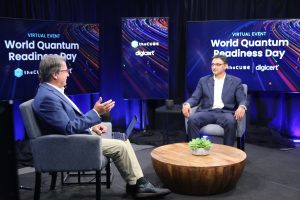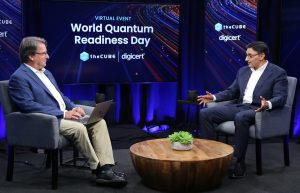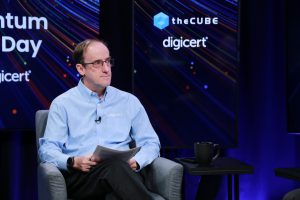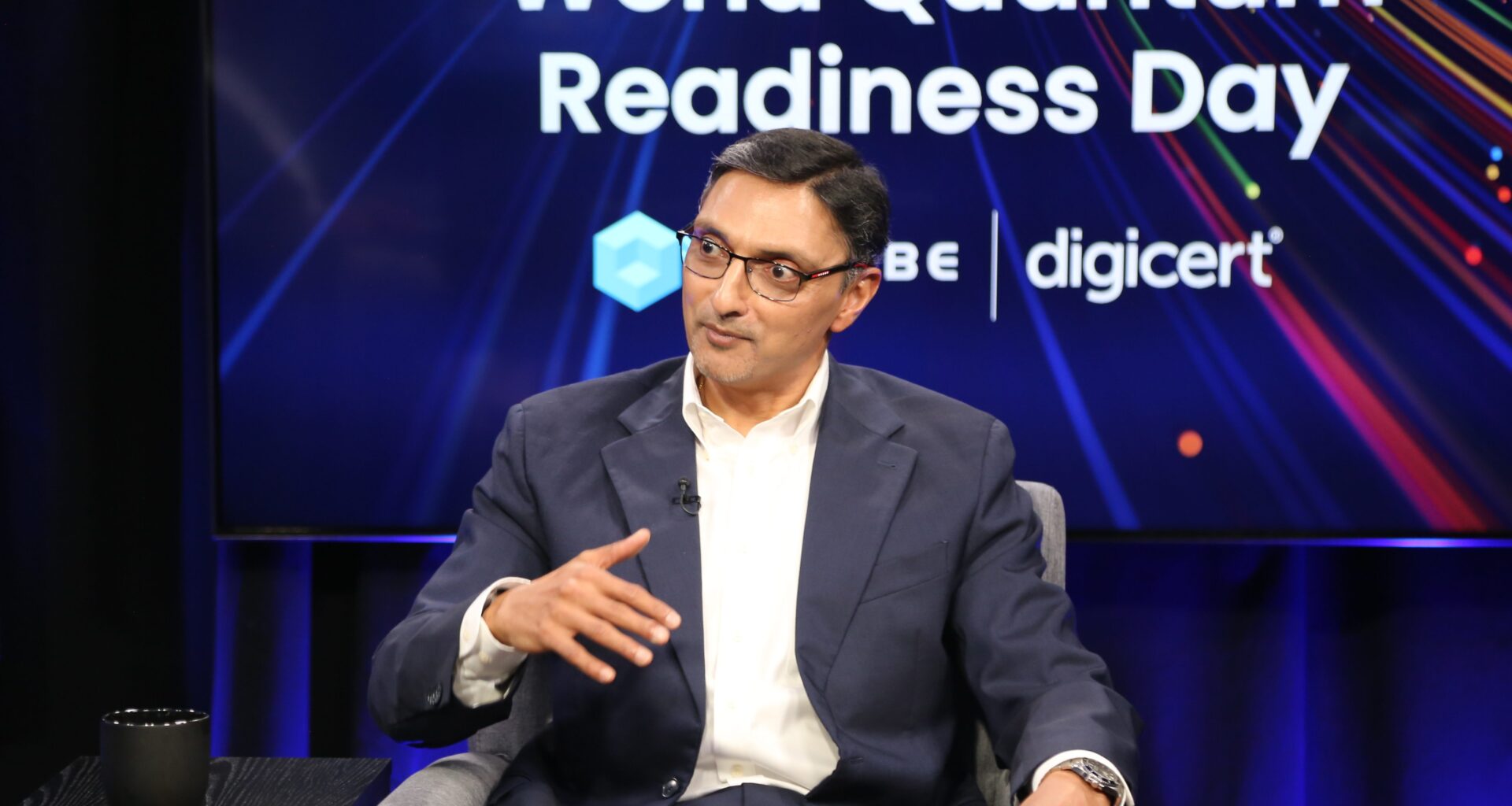As quantum computing moves from theory to reality, the security landscape is undergoing a rapid and inevitable transformation. Organizations are reworking their security systems, using new post-quantum standards and more flexible tools to keep digital trust strong in the quantum era.
These developments were a major focus of theCUBE’s coverage of the DigiCert World Quantum Readiness Day event. Moving to quantum represents a huge opportunity for organizations, according to Amit Sinha (pictured), chief executive officer of DigiCert Inc.

DigiCert’s Amit Sinha talks with theCUBE about the urgent need for organizations to prepare for quantum computing.
“My bet is this is the year where most organizations, the vast majority of them, accept that the time to act is now, he told theCUBE during the event. “They all have to move and upgrade their digital trust fabric to make it quantum-safe.”
During the event, experts discussed how DigiCert is helping enterprises prepare for a post-quantum future by operationalizing post-quantum standards and building practical roadmaps for adoption. TheCUBE’s coverage featured interviews with industry leaders about cryptographic modernization, implementation of post-quantum standards, real-world customer strategies and more. (* Disclosure below.)
Here’s three key insights you may have missed from theCUBE’s coverage:
Insight 1: Post-quantum standards are accelerating as quantum advances.
Quantum computing has moved from a distant concern to an urgent reality as rapid technological advances and shrinking timelines force organizations to act faster. Part of the reason why people are still in denial is because conversation around quantum computing have been going on for an extended period of time, according to Sinha.
“IBM was a pioneer and continues to be a pioneer in quantum computing, chipsets and infrastructure,” Sinha said during the event. “But more recently, if you look at all the hyperscalers, Google, Microsoft, AWS, and more recently, Nvidia and Cisco, they’ve all announced their bigger, faster, better quantum processors.”
In many ways, this moment mirrors the early days of transistors, similar to the era of the Intel 4004 and the first generation of chips, according to Sinha. Quantum computing is still in its infancy, but progress is accelerating rapidly.

DigiCert’s Amit Sinha talks with theCUBE’s John Furrier about adopting post-quantum cryptography, modernizing certificate management and building digital trust ahead of the 2029 deadline.
“Most of the companies are addressing two problems. One is, ‘How do I have more qubits, quantum bits, similar to the early days of transistors? How do I pack more transistors and get more memory and more processing capabilities?’” Sinha said. “The other aspect is, ‘How do I fix error correction so I can get more logical qubits out of the same physical number of qubits?’ Because errors in quantum computing is a big problem that needs to be solved.”
Quantum computing will eventually have its own “ChatGPT moment,” according to Sinha. One day, people will suddenly realize how quickly and profoundly the technology has transformed everything.
“It’s been cooking for a while,” Sinha said. “All of the big tech firms are in a race for quantum supremacy, because they view this as the next big thing.”
Insight 2: Quantum readiness demands immediate, practical cryptographic action.
Quantum readiness is rapidly evolving from concept to imperative as industries prepare for a post-quantum future guided by emerging post-quantum standards. Leading organizations are already taking action, turning quantum risk into an opportunity to modernize security and build lasting digital resilience.
Many enterprises are starting by becoming their own first customer, testing solutions internally to uncover challenges before clients encounter them. DXC Technology Co. has adopted this “customer-zero” model across its global workforce to gain real-world insight and build credibility with customers, according to Martin Reilly, digital identity offering manager at DXC Technology.
“By being our own customer zero, that gave us the learnings and insight and discoveries to build that framework which we can then apply to our customers and use that to build the infrastructure they need to take themselves forward based on our learnings,” he said during the event.
Enterprises face significant technical challenges as they implement larger key sizes and new algorithms, often encountering compatibility issues across existing infrastructure. Still, companies such as Cloudflare Inc. are overcoming these hurdles through careful testing and close collaboration with vendors, according to Luke Valenta, systems engineer, cryptography, at Cloudflare.

DigiCert’s Tim Hollebeek talks with theCUBE about the technical, operational and strategic dimensions of digital certificate transformation.
“By the end of this year, we actually expect that a majority of human-initiated connections at Cloudflare will be protected with post-quantum encryption,” he said during the event. “It slowed down the post-quantum encryption rollout quite a bit. But with careful rollouts and communication with vendors to fix all these bugs, we’ve gotten to a really good place.”
As organizations make progress on quantum readiness, attention is turning to the foundation of digital trust itself. When it comes to public key infrastructure, the challenge now lies in maintaining security and interoperability during the shift to post-quantum cryptography.
Enterprises are deciding whether to maintain parallel public key infrastructures — one classical and one post-quantum — or adopt hybrid structures that connect the two. The real challenge lies not in the cryptography itself but in managing this transition without disrupting trust, according to Tim Hollebeek, vice president of industry standards at DigiCert.
“I think if we could convince everybody that … next year, we’re just going to shut down the internet for a year and fix everything and upgrade it — that would be pretty easy because the end state and the starting state are pretty simple,” he said during the event. “Of course, people aren’t going to really tolerate us shutting down the internet for a year. So, we have to have this operating correctly with both algorithms in the middle while the transition happens. I think that’s actually going to be the biggest challenge for organizations.”
As enterprises work to modernize their PKI and navigate the complex shift to post-quantum trust models, the next phase of readiness is unfolding through real-world testing. By developing post-quantum cryptography, cybersecurity experts at Wells Fargo Bank & Co., Accenture PLC and DigiCert hope to prepare companies for the migration to quantum-based cybersecurity.
“Pilots are a really important way to focus when you’re looking at a [post-quantum cryptography] migration,” Tom Patterson, managing director of emerging technology security at Accenture, told theCUBE. “It validates an approach or helps you learn about what approach would work best in your environment, but it also helps to make this real for the rest of your organization.”
Insight 3: Quantum security requires proactive hybrid transformation.
As quantum computing and post-quantum standards accelerate, security leaders are shifting from awareness to action, rethinking how to safeguard data and trust in a post-quantum world. Quantum cyber readiness means protecting today’s sensitive data from tomorrow’s quantum threats through early, proactive planning and a trusted digital foundation, according to Colin Soutar, managing director at Deloitte Touche Tohmatsu Ltd.
“We’re seeing a marked uptick in the connection between post-quantum cryptography updates and things like public key infrastructure, PKI upgrades or modernization,” he said during the event. “As we go through the next couple of years, and the majority of organizations will be further along in their upgrades to post-quantum cryptography, what we think is going to happen is that there will essentially be two levels of trust. That’s where we think there’ll be the emergence of a cost of not upgrading.”
As organizations move from planning to implementation, that shift is taking shape through new cryptographic standards such as Module-Lattice-Based Key-Encapsulation Mechanism, or ML-KEM. Securing your data now is essential, according to Shane Kelly, principal crypto architect at DigiCert.
“An attacker can take the data that you’re transmitting now,” he told theCUBE. “They can store it somewhere, and when there is a relevant quantum computer, they can start to decrypt it. The higher value your information, the more likely you’re going to be susceptible to this type of attack. Medical information, confidential information, banking information … that’s going to be susceptible.”
As organizations adopt new encryption standards, attention is also turning to digital signatures, where algorithms such as Module-Lattice-Based Digital Signature Algorithm, or ML-DSA, are being tested as the next critical step in post-quantum protection. ML-DSA presents challenges with larger keys and deployment complexity, but its long-term stakes make the investment worthwhile, according to William Whyte, senior director of technical standards at Qualcomm Inc.
“If we weren’t concerned about quantum computers, we probably wouldn’t be migrating to ML-DSA anytime soon,” Whyte said during the event. “But we know that those migrations need to happen.”
Stay tuned to watch more of theCUBE’s coverage of the DigiCert World Quantum Readiness Day event.
(* Disclosure: TheCUBE is a paid media partner for the DigiCert World Quantum Readiness Day event. Neither DigiCert Inc., the sponsor of theCUBE’s event coverage, nor other sponsors have editorial control over content on theCUBE or SiliconANGLE.)
Photo: SiliconANGLE
Support our mission to keep content open and free by engaging with theCUBE community. Join theCUBE’s Alumni Trust Network, where technology leaders connect, share intelligence and create opportunities.
15M+ viewers of theCUBE videos, powering conversations across AI, cloud, cybersecurity and more
11.4k+ theCUBE alumni — Connect with more than 11,400 tech and business leaders shaping the future through a unique trusted-based network.
About SiliconANGLE Media
SiliconANGLE Media is a recognized leader in digital media innovation, uniting breakthrough technology, strategic insights and real-time audience engagement. As the parent company of SiliconANGLE, theCUBE Network, theCUBE Research, CUBE365, theCUBE AI and theCUBE SuperStudios — with flagship locations in Silicon Valley and the New York Stock Exchange — SiliconANGLE Media operates at the intersection of media, technology and AI.
Founded by tech visionaries John Furrier and Dave Vellante, SiliconANGLE Media has built a dynamic ecosystem of industry-leading digital media brands that reach 15+ million elite tech professionals. Our new proprietary theCUBE AI Video Cloud is breaking ground in audience interaction, leveraging theCUBEai.com neural network to help technology companies make data-driven decisions and stay at the forefront of industry conversations.

